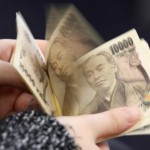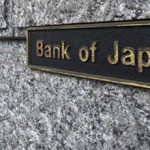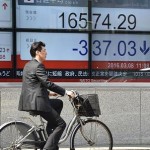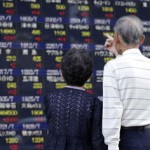Yen at 85 Seen by Tokai Predicting BOJ Policy Miss: Japan Credit
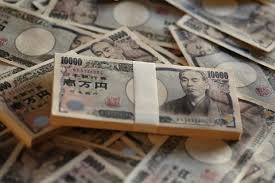
The Bank of Japan’s failure to achieve its inflation target will see the yen rebound to the highest since 2012, reversing the results of its unprecedented stimulus, according to Tokai Tokyo Securities Co.
The currency will strengthen beyond 85 per dollar “by this fall,” said Kazuhiko Sano, the chief bond strategist at Tokai Tokyo. The yen is trading within 1 percent of its fair value of 102.61 implied in the Organization for Economic Cooperation and Development’s measure of purchasing power parity and weakened beyond the threshold for the first time since 1985 last year. The currency surged 65 percent in four years to a record the last time it approached equilibrium in June 2007.
“The PPP index shows the yen weakness has gone too far, signaling a strengthening trend,” Sano said by phone from Tokyo yesterday. The BOJ’s inflation target “will be difficult to achieve without the yen reaching 120 against the dollar.”
BOJ Governor Haruhiko Kuroda doubled monthly bond purchases in April last year to end deflation, driving an 8.8 percent drop in the yen’s nominal value and helping bolster inflation to the highest since 2008 in December. Price growth has since stalled at 1.3 percent, short of the central bank’s 2 percent target. The Japanese currency is the least overvalued among the dollar’s 10 major peers, suggesting it is poised for a rally that may undo the central bank’s depreciation efforts.
Yield Forecast
Sano, who in May 2012 correctly predicted last fiscal year’s plunge in Japan’s benchmark bond yield to 0.5 percent, forecasts a record low of 0.25 percent this year as the yen strengthens. The securities yielded 0.605 percent today. The currency traded at 101.65 as of 10:12 a.m. in Tokyo, a 3.6 percent advance since Dec. 31.
“A long-term devaluation of the yen is not possible without Japanese inflation continuing to outpace that of the U.S.,” Sano said. “The yen’s strength is based on the premise of a price gap.”
Japan’s gross-domestic-product deflator, the broadest measure of the cost of living, has been below zero since December 2009 even as headline inflation picked up. The equivalent gauge in the U.S. averaged 1.5 percent in the period. The purchasing-power-parity rate equates consumer prices in Japan with those in the U.S.
Against Consensus
Sano’s outlook on the yen and benchmark yield is in the minority. The median analyst estimate compiled by Bloomberg calls for the currency to weaken to 109 against the dollar by the end of the year, with 97 as the most bullish forecast. The 10-year interest rate will probably increase to 0.83 percent, according to the data.
Any advance in the yen beyond 100 per dollar may be short-lived as demand for the currency has weakened from exporters that need to repatriate their overseas earnings, according to Satoshi Okagawa, a senior global-markets analyst in Singapore at Sumitomo Mitsui Banking Corp.
“The supply-demand balance has greatly changed” because of Japan’s deteriorating trade balance, said Okagawa, whose company is a unit of Japan’s second-biggest financial group by market value. “There is clearly more buying” than selling of dollars for yen, he said.
Japan recorded a 21th straight month of trade deficits in March, according to data from the finance ministry. The current-account shortfall reached a record 1.6 trillion yen ($15.7 billion) in January. Japan has posted a surplus every year since 1981 in the broadest trade gauge, enabling it to become the world’s largest creditor.
BOJ’s Outlook
The central bank is buying about 7 trillion yen in sovereign notes a month to achieve Prime Minister Shinzo Abe’s price-growth goal. The monetary easing is part of the three so-called arrows of Abenomics, which also include government spending and deregulation.
BOJ board members forecast that inflation will accelerate to 1.9 percent in the year starting April 2015 and to 2.1 percent the following period excluding the effect of a higher sales tax. Nearly all economists surveyed by Bloomberg News said the BOJ will miss its goal in the fiscal year starting next April and 75 percent forecast more stimulus by the end of the year, according to the poll conducted May 2-8.
The central bank lowered an outlook for real gross domestic product this year to 1.1 percent from a January projection of 1.4 percent. GDP will probably contract an annualized 3.35 percent in the second quarter, the sharpest drop in three years, after the levy increase to 8 percent from 5 percent last month, a Bloomberg survey showed.
The yen’s gain this year and a chill from higher taxes are “threatening to pull the rug out from under Abenomics,” according to Nicholas Spiro, managing director in London at Spiro Sovereign Strategy.
“Foreign investors, which had been betting on a weaker yen, are now much less confident about Abenomics — and rightly so,” Spiro said in an e-mailed answer to Bloomberg questions. “The catalysts for a weaker Japanese currency have become much less pronounced, or have simply run their course.”
(By Yumi Ikeda and Masaki Kondo)
Source: bloomberg









